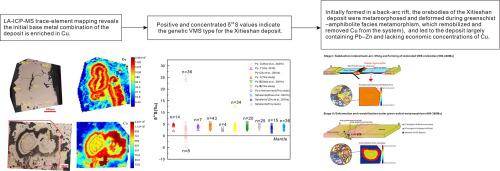Ore Geology Reviews ( IF 3.3 ) Pub Date : 2022-09-13 , DOI: 10.1016/j.oregeorev.2022.105103 Zhi-Jie Feng , Tao Yang , Xizhu Yao , Matthew J. Brzozowski , Ru-Xiong Lei , Chang-Zhi Wu

|
Although volcanogenic massive sulfide (VMS) deposits always form in extensional settings, many have been reworked by metamorphism, deformation, and the circulation of hydrothermal fluids during subsequent accretionary events. The genesis of VMS deposits has been well documented, however, the mechanisms that rework the mineralization have been relatively poorly constrained. An understanding of these mechanisms, though, is critical to the development of robust mineral deposit models as they are capable of remobilizing ore-forming metals. The Xitieshan Pb–Zn deposit, located in Qinghai Province, western China, is the third largest Pb–Zn deposit in China, with a total Pb–Zn metal reserve of 6.4 million tons. The occurrence of laminated and non-laminated orebodies in the Xitieshan deposit make it an ideal candidate to i) constrain the effects of metamorphic and hydrothermal processes on remobilization of metals in these base-metal systems, and ii) assess the genetic nature of this deposit. This is accomplished here by integrating new S isotope data and trace-element chemistry of sulfides from laminated ores with previous information on regional and deposit geology, and deformation characteristics preserved by the mineralized system. The S isotope composition of pyrite and sphalerite grains from laminated ores are consistently positive and range from 2.08 ‰ to 5.81 ‰, indicative of mixing of reduced sulfur from three distinct sources — volcanic rocks, seawater and thermochemical reduced sulfate, which is typical of VMS deposits globally. Greigite (Fe3S4) grains in laminated ores exhibit oscillatory zonation with respect to Cu, Co, Mn, Sb, and Tl concentrations; such compositional variations indicate that at least some of the primary VMS mineralization characteristics have been preserved despite subsequent reworking by metamorphism, deformation, and hydrothermal circulation. Combined with the results of previous studies, a two-stage genetic model is proposed for the formation and modification of the Xitieshan Pb–Zn deposit — i) initial formation of the primary Pb–Zn mineralization with minor of Cu, and ii) subsequent metamorphism and hydrothermal reworking of the deposit, which did not completely destroy the textural and chemical characteristics of the primary mineralization.


























 京公网安备 11010802027423号
京公网安备 11010802027423号